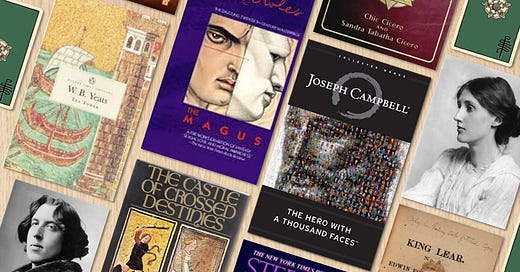In this post:
Tarot, Literally is a chapter pulled from my new book, Mystic Storyteller: A Writer’s Guide to Using the Tarot for Creative Inspiration
What Story Comes to Mind? A 3-Card Spread
Pre-Order Mystic Storyteller
In the introduction of my new book, Mystic Storyteller: A Writer’s Guide to Using the Tarot for Creative Inspiration, I share my history of how using the tarot helped me write my fiction duology, The Scars We Choose. While my venture with the cards began with the uncovering of a single fictional character, and my subsequent exploration of the tarot cards she was reading, many writers before me have used the tarot for inspiring their own stories.
Historical examples date as far back as William Shakespeare, whose foolish characters were likely informed by The Fool card, the first card of the Major Arcana, which had been circulating for at least two centuries prior amongst the lineage of European aristocrats and alchemists who heavily supported his work.1 Widely regarded as one of his most famous fools, King Lear’s trusted advocate takes on many qualities of the tarot’s Fool: honesty, loyalty, wittiness, and irony.
Furthermore, when writing his final novel, The Winter of Our Discontent (1961), John Steinbeck was influenced by T. S. Elliot and other writers whose work the tarot had inspired.2 Additionally, Joseph Campbell’s The Hero with a Thousand Faces (1973) outlines the Hero’s Journey, the adventure model that directly informed A. E. Waite’s “Fool’s Journey,” or the 22 cards of the Major Arcana. You’ll learn all about these journeys in Mystic Storyteller.
Tarot cards are also mentioned in The Magus (1965), by John Fowles, and in Italo Calvino’s novel The Castle of Crossed Destinies (1979), his characters use the cards for storytelling purposes along their travels. Moreover, poet couple Sylvia Plath and Ted Hughes heavily relied upon the tarot and its overlapping Kabbalistic principles for many of their poems, essays, and fiction writings.
Stephen King’s works such as Danse Macabre (1981) and The Gunslinger (1982), the first of eight novels in The Dark Tower series, suggest the horror author was familiar with and inspired by the tarot. In the former, King identifies what he refers to as “the three tarot cards of horror.”3 These archetypes, which he asserts are the basis for all monsters, are the Werewolf, the Vampire, and the Thing. Like the tarot, these three blood-thirsty archetypes have been interpreted in a myriad of ways throughout literature and folklore.
Although it’s not confirmed whether Virginia Woolf used the tarot or was inspired by the cards when penning her many novels and themes, the celebrated author was directly connected to a web of artists and writers who were. To start, Woolf was a fan of William Butler Yeats, having reviewed his poetry collection, The Tower (1927), which was deeply imbued with tarot symbolism. Additionally, she shared a 20-year friendship with T. S. Eliot, whose poem The Waste Land was published by her publishing company, Hogarth Press, in 1922. In the poem, Eliot mentions Madame Sosostris, “a famous clairvoyante… With a wicked pack of cards.”4 Moreover, Yeats, Eliot, and Woolf’s friend, actress Ellen Terry, were all members of the Hermetic Order of the Golden Dawn, a secret society that devoted their time to studying and practicing subjects related to religious symbology, the occult, metaphysics, and the paranormal. Coincidentally, Ellen Terry was also a dear friend to Pamela Colman Smith, the artist behind the most popular tarot card images in the world. Terry even bestowed Smith with her nickname, “Pixie.” In addition, writers A. E. Waite, Oscar Wilde, and Bram Stoker were all Golden Dawn members.5
It’s impossible to know every writer or artist to have been inspired by the tarot. However, thanks to modern technology and diligent researchers, we know more now about the artist behind the most popular tarot images than ever before. Find out more about Pamela Colman Smith, also known as “Pixie,” here in this post I published while writing my new book.
What story comes to mind?
Below, you can see three cards I’ve selected from my companion deck, Mystic Storyteller Tarot. When looking at these cards—either together or separately—which stories come to mind? Of which books or characters do the cards remind you? Share in a comment! I’d love to know your interpretation.
Pre-Order MYSTIC STORYTELLER
Mystic Storyteller is a book and companion tarot deck for writers who want to enhance their creativity, elevate storytelling, develop fiction plots and scenes, and so much more.
About Mandy
Amanda "Mandy" Hughes is an author and instructional designer who uses the tarot to inspire storytelling. Her book Mystic Storyteller: A Writer’s Guide to Using the Tarot for Creative Inspiration and companion tarot deck are helping her peers do exactly that. She also writes fiction under pen name A. Lee Hughes. Mandy lives in Georgia with her husband and four sons, two of whom are furrier than the others (but not by much). Visit her website at www.haintbluecreative.com and find her on Substack @HaintBlueCreative.
Pierce, C. A. (2016, November 8). “An O without a figure”: The Fool and the Concept of Zero in King Lear. Crossroadstarot. https://crossroadstarot.wordpress.com/2016/11/08/an-o-without-a-figure-the-fool-and-the-concept-of-zero-in-king-lear/#more-291
Kasparek, C. A. (1984). Ethan’s Quest Within : A Mythic Interpretation of John Steinbeck’s The Winter of Our Discontent. http://liblink.bsu.edu/catkey/225291
Auger, E. E. (2018). Tarot and T.S. Eliot in Stephen King’s Dark Tower Novels [Article]. SWOSU Digital Commons. https://dc.swosu.edu/mythlore/vol36/iss2/22/
Pierce, C. A. (2015, August 8). Don’t Be Afraid of Virginia Woolf: Tarot Imagery in “The Searchlight.” Crossroadstarot. https://crossroadstarot.wordpress.com/2015/08/08/dont-be-afraid-of-virginia-woolf-tarot-imagery-in-the-searchlight/
Kaplan, S. R. (2018). Pamela Colman Smith: The Untold Story. U.S. Games Systems Inc.








